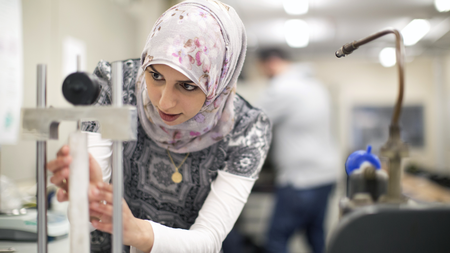
Reader
- About
-
- Email Address
- murilo.baptista@abdn.ac.uk
- Telephone Number
- +44 (0)1224 272489
- Office Address
University of Aberdeen
Institute for Complex Systems and Mathematical Biology
Meston Building, Meston Walk
Aberdeen AB24 3UE
- School/Department
- School of Natural and Computing Sciences
Biography
Since 2014, I am a Reader of the University of Aberdeen, having joined it in 2009 as a Senior Lecturer. Before that, I worked as a postdoc, guest scientist, or guest assistant professor at 5 Universities and Institutes in USA, Brazil, Germany, and Portugal. I have interest in understanding the relationship among function (e.g., information, collective behaviour and synchronisation) and structure in large networked complex systems for its posterior modelling, having contributed to works in neuroscience, smart engineering systems, and sustainability of the Earth. My work is supported by analytical developments, but I also rely on the analysis and modelling of data using techniques from data sciences, nonlinear time-series analysis, and machine learning. I am a leading scientist in the area of chaos-based communication, where I am working to show that chaos offers alternative technologies for efficiently smart (and secure) wireless communication systems.
- Research
-
Research Overview
I have interest in understanding the relationship among function (e.g., information, collective behaviour and synchronisation) and structure in large networked complex systems for its posterior modelling, having contributed to works in neuroscience, smart engineering systems, and sustainability of the Earth. My work is supported by analytical developments, but I also rely on the analysis and modelling of data using techniques from data sciences, nonlinear time-series analysis, and machine learning. I am a leading scientist in the area of chaos-based communication, where I am working to show that chaos offers alternative technologies for efficiently smart (and secure) wireless communication systems.
Research Areas
Accepting PhDs
I am currently accepting PhDs in Physics, Maths, Engineering.
Please get in touch if you would like to discuss your research ideas further.



Research Specialisms
- Mathematical Modelling
- Applied Mathematics
- Dynamics
- Information Technology
- Neural Computing
Our research specialisms are based on the Higher Education Classification of Subjects (HECoS) which is HESA open data, published under the Creative Commons Attribution 4.0 International licence.
Current Research
I am working to understand optimal configuration to communicate wirelessly with chaos in the air and in space, to model synapses and their information capacity, predict degradation in vessels, to understand how synchronisation emerges in networks with connections of higher order, to model how arguments in a networks of agents predominates, to understand the causal relationship of socio and economic variables in Brazil, to explain the topological changes suffered in the brain of patients that have undergone brain surgeries due to tumours.
Past Research
During my PhD, we discovered that the driven Chua’s chaotic circuit presented a transition to chaos via destruction of a two-frequency torus. Though this route was known, the description of topological changes suffered by the chaotic attractor was not. Later on, I work to define the phase of chaotic oscillators. Though the phase of a periodic signal is a well-known quantity, for chaotic trajectories, it is not. Our work has proposed a mathematical framework to define and measure it.
To secure communication systems based on chaos, the chaotic wave signal encoding information should not be transmitted. Instead, one could transmit the trajectory’s Poincaré first return times (PFRT). This understanding resulted in the cipher today one of the founding references for the area of chaos-based cryptography. We have proved (see http://hdl.handle.net/10216/65184) a conjecture that the distribution of PFRTs can be analytically calculated by the eigenvalues of the unstable periodic orbits of the chaotic attractor, and shown that a very important and popular quantity to characterise chaotic behaviour - the Kolmogorov-Sinai entropy – can be estimated from PFRTs.
Typically, chaotic behaviour in a nonlinear system is replaced by periodic behaviour even when arbitrarily small parameter alterations are made. I worked on experiments to demonstrate this and validate works that explain why periodic behaviour is ubiquitous in nature, came in Ref. [42,90].
My work in neural networks with neurons connected by both electrical and chemical synapses has provided a rigorous ground to explain the regulatory effect that electrical synapses have in the brain. The study of such networks, known as multiplex networks, only became a topic of attention by the scientific community by 2013. We have proposed a formula for the mutual information in terms of Lyapunov exponents (that quantify chaos) and used to provide support for the Infomax theory that suggests that the brain evolve by maximising information. We have discovered the phenomenon of Collective Almost Synchronization, ubiquitous in complex networks, and that has been shown to be crucial for the chaos enhancement of machine learning methods to model and predict EEG signals. I have also shown that the cause-effect relationship between variables, or causality (and that is usually characterised by temporal quantities), is a spatial-temporal phenomenon. Finally, we have shown that a power grid without control systems can be designed to be reliable by properly connecting generators and consumers.
- Publications
-
Page 2 of 18 Results 11 to 20 of 171
Construction of Piecewise Chaotic Maps With Tunable Statistical Mean
Chapters in Books, Reports and Conference Proceedings: Conference Proceedings- [ONLINE] DOI: https://doi.org/10.1109/MOCAST57943.2023.10176612
Plastic neural network with transmission delays promotes equivalence between function and structure
Chaos, Solitons and Fractals, vol. 171, 113480Contributions to Journals: ArticlesThe interface of disasters, sanitation, and poverty in Brazil: a sociological perspective
Frontiers in Sustainable Cities, vol. 5, 1184532Contributions to Journals: ArticlesChaotification of 1D maps by Multiple Remainder Operator Additions: Application to B-Spline Curve Encryption
Symmetry-Basel, vol. 15, no. 3, 726Contributions to Journals: ArticlesChaotification of One-Dimensional Maps Based on Remainder Operator Addition
Mathematics, vol. 10, no. 15, 2801Contributions to Journals: ArticlesInverse Problems for Gradual Semantics
Chapters in Books, Reports and Conference Proceedings: Conference Proceedings- [ONLINE] DOI: https://doi.org/10.24963/ijcai.2022/377
- [ONLINE] https://www.ijcai.org/proceedings/2022/0377.pdf
What Lies Behind the Acute Crises: The Social and Infrasystems Links with Disasters in Brazil
Sustainable Development Goals Series. Springer, pp. 35-52, 18 pagesChapters in Books, Reports and Conference Proceedings: Chapters- [ONLINE] DOI: https://doi.org/10.1007/978-981-16-8352-7_3
- [ONLINE] View publication in Scopus
Analytical Solutions for the Inverse Problem within Gradual Semantics
Working Papers: Preprint Papers- [ONLINE] DOI: https://doi.org/10.48550/arXiv.2203.01201
- [OPEN ACCESS] http://aura.abdn.ac.uk/bitstream/2164/19104/1/2203.01201v1.pdf
- [ONLINE] http://arxiv.org/abs/2203.01201v1
The Inverse Problem for Argumentation Gradual Semantics
Working Papers: Preprint Papers- [ONLINE] DOI: https://doi.org/10.48550/arXiv.2202.00294
- [OPEN ACCESS] http://aura.abdn.ac.uk/bitstream/2164/21380/1/2202.00294v1.pdf
- [ONLINE] http://arxiv.org/abs/2202.00294v1
Infrastructuring with CareCare in Cities of the Global SouthGlobal South
Urban Infrastructuring: Reconfigurations, Transformations and Sustainability in the Global South. Springer, pp. 309-319, 11 pagesChapters in Books, Reports and Conference Proceedings: Chapters- [ONLINE] DOI: https://doi.org/10.1007/978-981-16-8352-7_19
- [ONLINE] View publication in Scopus
